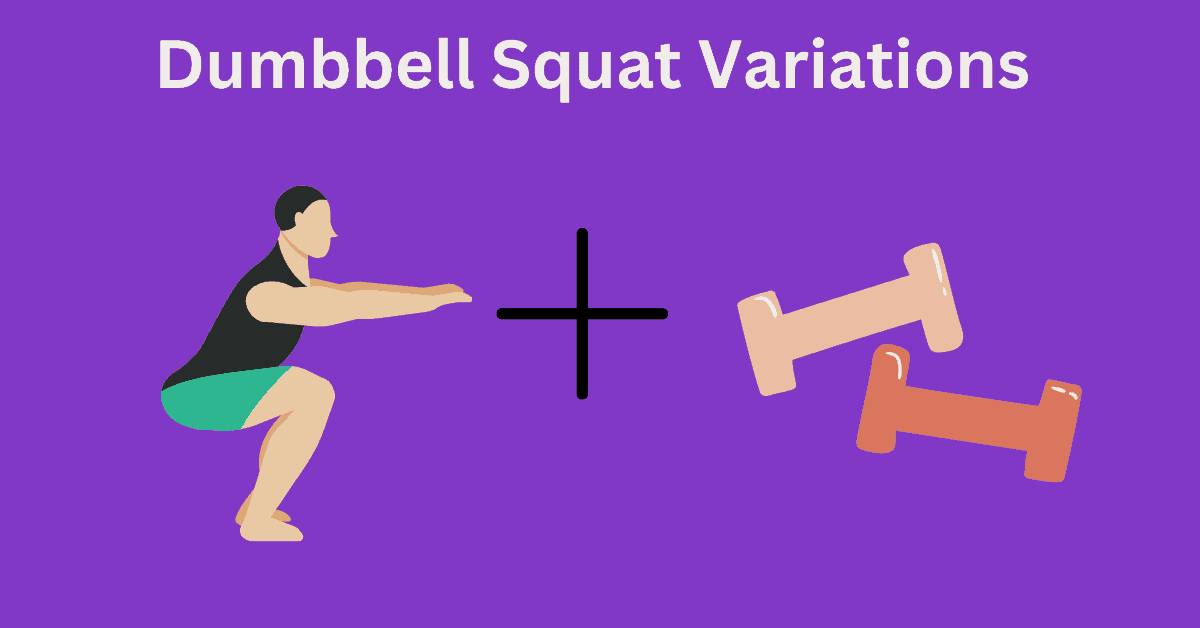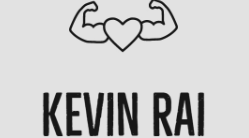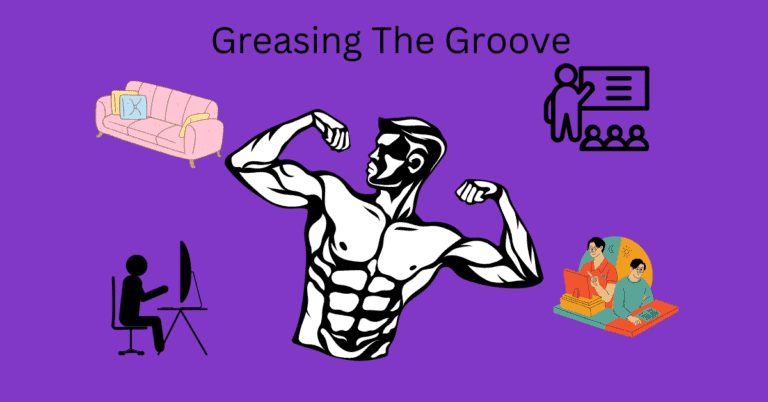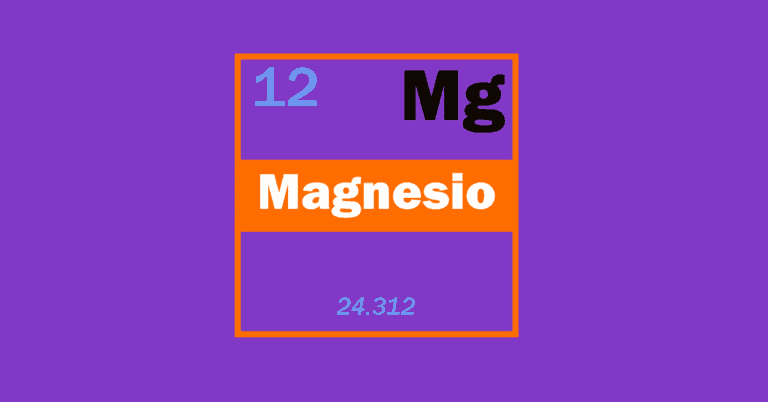7 Best Dumbbell Squat Variations: Build Strength & Power

When it comes to building a pair of sculpted legs, it’s undeniable that squats are the most effective exercise for the job.
It doesn’t only target your lower body but also your upper body muscles as well~ which is why some people call it the king of all exercises.
Performing squats with dumbbells gives you the ability to change hand grips & position, which will slightly target different muscles.
I will reveal all the necessary dumbbell squat variations you need in the article to upgrade your lower body workout to the next level!
What Are The Best Dumbbell Squat Variations?
- Dumbbell Goblet Squat
- Dumbbell Front Squat
- Dumbbell Overhead Squat
- Dumbbell Sumo Squats
- Bulgarian Split Squat
- Jump Squats
- Dumbbell Box Squat
Dumbbell Goblet Squat
It gets its name from the goblet-like grip used to hold the dumbbell.
As you will be holding the dumbbell in front of you, this will not only challenge your lower body muscles but also your grip & upper back as well.
- Start by placing your feet at a distance you feel comfortable at.
- Hold a dumbbell vertically with both hands by cupping the head of it.
- Push your hips back while bending your knee to initiate the squatting motion.
- Lower your body until your thighs are at least parallel to the ground, or as far as your mobility allows.
- Press through your heels to get back to the starting position.
Extra Tips
- When holding the dumbbell keep your elbows pointing downward, creating a “goblet” shape with your hands.
- If you struggle to maintain a firm grip on the dumbbell throughout the movement, bring it closer to your chest for added support. Vice versa, if you want to challenge your grip strength, then bring it a bit away from the body.
Dumbbell Front Squat
Similar to the goblet squat, the weight is positioned in front of you.
However, with the front squat, the dumbbell is held at shoulder height, shifting the center of gravity more forward. This demand puts a higher level of pressure on the core and upper back.
- Grab a pair of dumbbells with an overhand grip (palms facing your body).
- Bring the dumbbells above your shoulders and slowly rest them just outside your meaty section of the shoulder.
- Stand up tall and slowly squat down until you are parallel to the ground.
- Pause briefly at the bottom and feel a stretch on your quadriceps and glutes.
- Drive through your feet to get back up.
Extra Tips
- The weight will try to collapse your upper body forward. Therefore engage your core to provide stability to your upper back & spine.
- Keep your elbows pointing forward throughout the movement to prevent the dumbbells from dropping.
Dumbbell Overhead Squat
This is probably one of the toughest dumbbell squat variations on the list, so don’t be disheartened if you fail on your first couple of tries.
What makes this movement challenging is the amount of shoulder mobility required to hold the weight above you while squatting.
It might take some time to acquire the mobility required for it, but once you have it, you’ll have a beast of a workout in your arsenal.
- Hold a dumbbell in each hand with an overhand grip (palms facing forward).
- Position the dumbbells at shoulder height with your elbows fully extended.
- Tighten your core and keep your chest up.
- While maintaining the dumbbell overhead, squat down till your mobility allows.
- Push the group with your feet and drive yourself up back to the starting position.
Extra Tips
- As you squat down your hands will naturally want to drift forward, which can cause you to tip over. Therefore try to keep the weight directly overhead and your hands in line with your ears.
- To help balance the weight and prevent your body from leaning forward, shift your weight more towards your heels as you descend.
Dumbbell Sumo Squats
The sumo squat stance is a variation where your feet are positioned much wider than shoulder-width apart, resembling the stance of a sumo wrestler.
Having this wider stance alters the biomechanics of the body~ placing significantly more emphasis on the inner thighs compared to other types of dumbell squat variations.
- Start by moving your feet close to double your shoulder width apart and have your toes pointed slightly outward
- Hold a dumbbell in each hand with an overhand grip.
- Slightly lift your chin up and stare right in front of you.
- Slowly squat down until your body allows and pause briefly to feel a stretch on your inner thighs.
- To get back up, imagine you are splitting the floor in half with your feet.
Extra Tips
- If you lack mobility, you might lean forward while squatting down, rather than having a smooth up and down motion. In this case, bring your feet closer until you can squat with a straight back and widen your stance as your flexibility increases.
- Focus on keeping your knees in line with your toes throughout the exercise to maintain proper alignment and prevent excess stress on the knees.
Bulgarian Split Squat
If you want to take some stress off the upper body and target mainly your legs & glutes then this dumbbell squat variations is perfect for it.
Also as it’s a unilateral exercise, it requires greater activation of the stabilizing muscles to help balance your body. This enhances your body’s ability to balance, reducing the risk of falls and improving stability in everyday activities.
- Firstly you need a bench or a surface that’s your knee level to use it to elevate your leg.
- Grab a pair of dumbbells and stand facing away from the bench or elevated surface.
- Place the top of one of your feet on the bench behind you.
- Take 3 mini hops with your other foot.
- Bend your front knee and lower it until your back knee is just above the ground (Focus on keeping your weight centered on your front foot).
- Push through your front heel and engage your quadriceps & glutes to rise back to the starting position.
Extra Tips
- If you find the movement challenging, you can just start with your body weight in the beginning to build up strength.
- You might unconsciously place your shin on the bench to help you balance, however this will limit your range of motion. Remember to only have the top of your foot resting on the surface.
Jump Squats
For a goal of not only building strength but explosive power as well, then jump squats are a great alternative.
It is a high-intensity exercise making it an effective cardio workout that will contribute to endurance and overall cardiovascular health.
But it does put excess pressure on your joints, so if you already have existing joint complications, this exercise might not be for you.
- Grab two dumbbells and hang them by your sides naturally.
- Stand up tall with your feet shoulder-width apart.
- Begin by lowering your body into a squat position.
- When your thighs are parallel to the ground, explosively jump upwards by driving through your heels and extending your hips, knees, and ankles simultaneously.
- Land softly and with control back into the squat position to absorb the impact. Your knees should be slightly bent to reduce stress on the joints.
Extra Tips
- If possible find a soft surface to perform this exercise like on grass or a mat to reduce the impact on your joints.
- As soon as you land, you should get down to the squat position. This should be a fluid motion with no delays~ as it will support your body to absorb the impact efficiently.
Dumbbell Box Squat
If you are a beginner, box squats can be a great way to perfect your form and technique.
As the box provides a controlled stopping point, this allows you to work on gradually improving your range of motion while minimizing the risk of injuries.
- Find yourself a stable platform at around knee level (preferably)
- Grab 2 dumbbells and hang them by your side
- The width of your feet is completely up to you.
- Stand facing away from the surface
- Slowly lower your body down towards the box until your glutes touch the surface.
- As soon as you make in contact with the surface, immediately drive through your feet to stand back up to the starting position.
Extra Tips
- Choose a box height that allows you to achieve a depth where your thighs are parallel to the ground when seated.
- Make sure you control your descent~ do not just collapse onto the box
Advantages Of Dumbbell Squats Over Barbell Squats
There are a few advantages of using dumbbells over a barbell to perform squats and some of them are:
Versatility
It’s difficult to squat with a barbell without a squat rack, however dumbbells are more versatile.
All you need is a pair of dumbbells, and you can do the exercise at home, in the gym, or even outdoors. This versatility allows for consistent training regardless of your location or access to specialized equipment.
Lower Back-Friendly
Unlike barbell squats, where the bar rests on your upper back, dumbbell squats do not place direct pressure on your spine.
There are many dumbbell squat variations like bulgarian split squats and sumo squats where the pressure is mostly targeted on your lower half and takes the load off your upper body & spine.
Increased Range of Motion
Dumbbells can be held at your sides during squats, which allows for a greater range of motion compared to barbell squats.
This is especially beneficial for beginners who are struggling to hit depth during the exercise.
Disadvantages Of Dumbbell Squats Over Barbell Squats
While dumbbell squats offer numerous advantages, there are also some potential disadvantages to consider.
Less loading Capacity
Dumbbells have a limited load capacity compared to barbells for squats.
As you progress and become stronger, you may reach a point where the heaviest available dumbbells are not challenging enough, limiting your potential for continued strength gains.
Grip Fatigue
Holding dumbbells for an extended period during squats can lead to grip fatigue, especially when using heavier weights.
If your grip becomes a limiting factor rather than your legs and glutes, then the exercise might lose its value for being an effective lower-body workout.
Less Core Activation
With a back barbell squat where the bar is resting on the upper back~ it puts added pressure onto the spine.
To counteract this force and maintain an upright posture, the core muscles, including the abdominal muscles and erector spinae, must engage to stabilize the spine~ thus in the long run this can make your core stronger.
FAQ
Are Dumbbells Squat Effective As A Barbell Squat?
Dumbbell squats target the same muscles as a barbell squat, making it an effective exercise to build muscle & strength.
Is Dumbbell Squat Safe For Beginners?
If you are a beginner start with lighter weights initially to practice the form correctly.
Going as light as 1kg at the start to build up strength is absolutely fine. Then gradually increase the weight as you become more confident in your ability.
Is Dumbell Or A Barbell better For Building Muscles?
As dumbbells are more versatile in terms of being able to change forms~ you are able to pinpoint certain muscles better than a barbell~ allowing you to build more muscle all around.
Is Dumbell Or A Barbell better For Building Strength?
Strength correlates to the force created by your muscles, which basically means how much weight you can push or pull.
Since with a barbell, you can incorporate more weights, this trains your body to handle heavier loads, therefore leading to more strength gains.
Conclusion
Squats are a much-needed exercise to build strength and power in your lower body.
Each dumbbell squat variations on the list slightly targets different muscle groups in the body. You can switch them around depending on your fitness goals.
So, let’s pick up those dumbbells, step up to the challenge, and squat our way to new heights of strength and vitality!
Ps:
In terms of what’s better, a barbell or a dumbbell squat ~ I think both have their own upsides and none is superior to the others.
With a barbell, you are able to load up heavier weights therefore leading to better gains.
However, with dumbbells you can more specifically target certain muscles, making it a great tool to patch up any imbalances that are present.



